Affiliate links on Android Authority may earn us a commission. Learn more.
Own a gaming PC? Here's how to mine Ethereum for some passive income
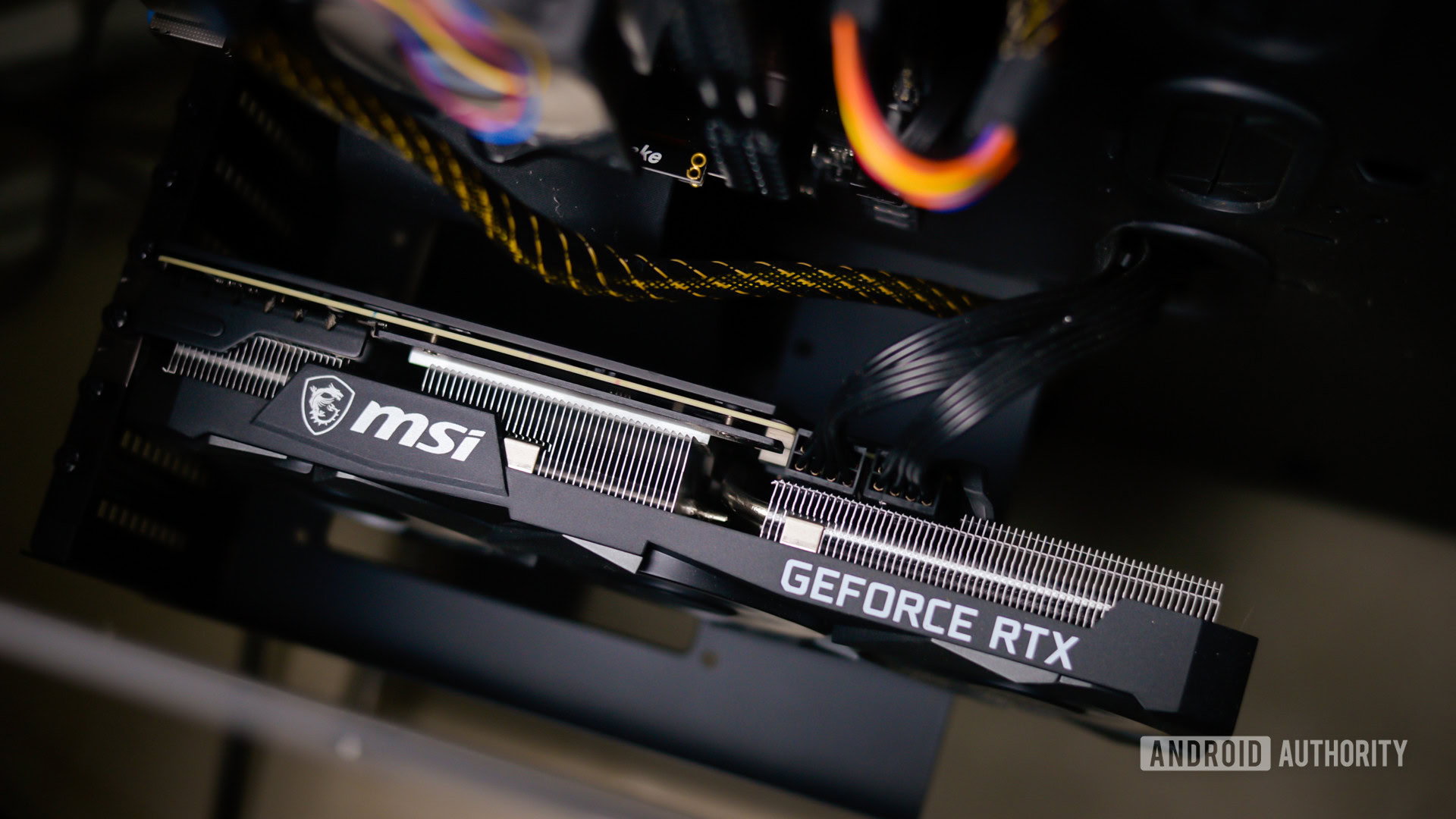
If you own a high-performance gaming computer or graphics workstation, you’re probably sitting on an untapped revenue stream. Cryptocurrency mining, or more specifically Ethereum mining, is often a profitable stream of income for many individuals and even entire businesses.
Mining tends to become so popular that the world’s largest graphics card manufacturers, NVIDIA and AMD, struggle to keep up with demand for their hardware — first in 2017 and then again in 2021. At the center of this hype and mania lies Ethereum, a cryptocurrency trying to democratize the financial industry and disrupt many others.
Despite the lucrative nature of Ethereum mining though, does it make sense for anyone with eligible hardware to participate? Follow along to learn more about cryptocurrency mining and how much money you can expect to make from it.
What is mining and why should you bother?
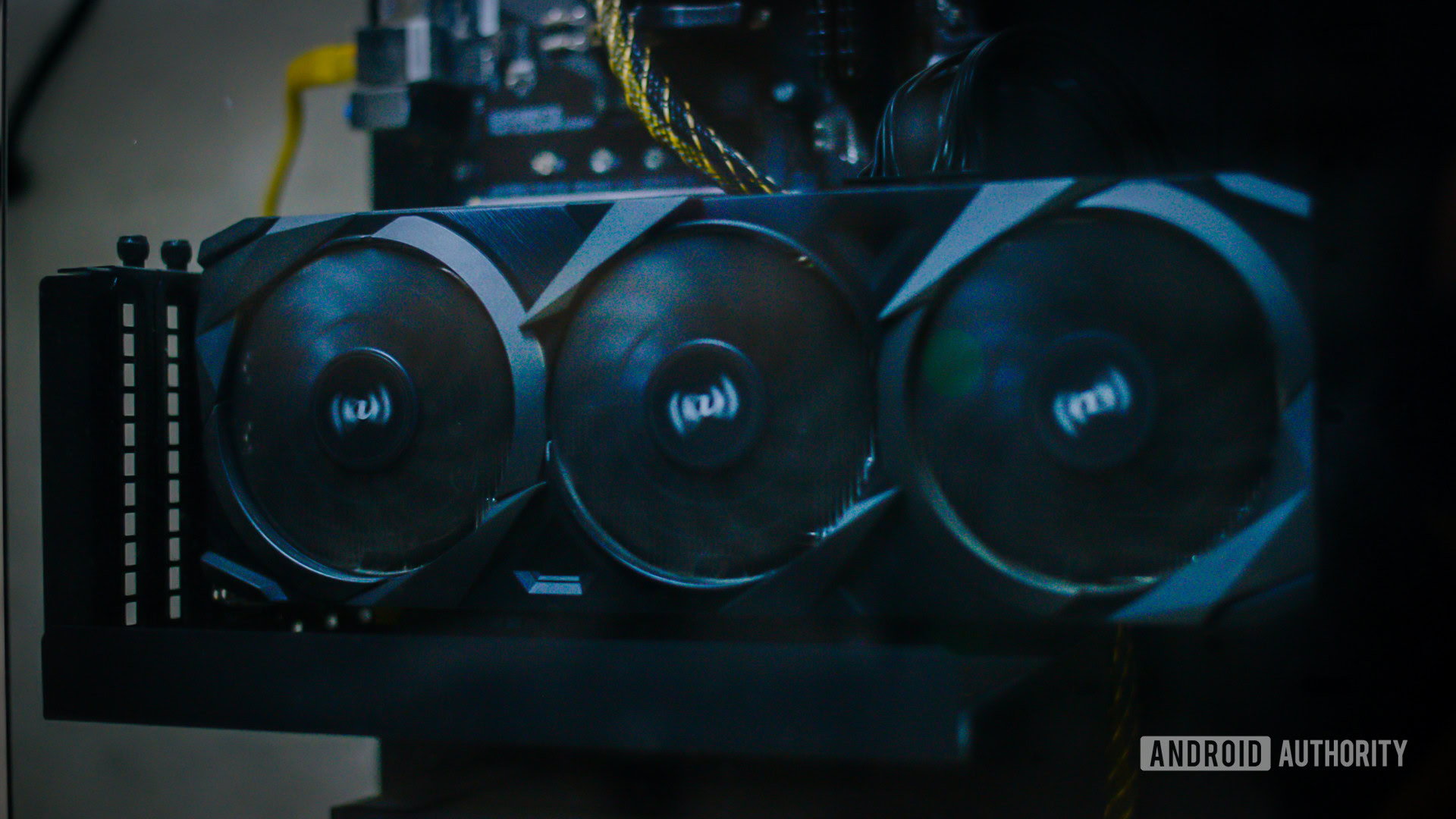
Put simply, mining is the process through which new cryptocurrency transactions are verified and added to the global ledger. Mining also prevents older transactions from being overwritten or fraudulently modified.
In most cryptocurrencies, new transactions are bundled together every few seconds in a block. Computers worldwide then calculate the solution to a complex mathematical problem, called a hash, unique to this block. The first computer (or miner) to find the solution is rewarded, while everyone else gets nothing and has to start over.
See Also: What is cryptocurrency mining? Why is it so important?
Anyone can volunteer to become a cryptocurrency miner. As long as you have a powerful enough computer and an internet connection, you can expect to make some money. However, some cryptocurrencies like Bitcoin, Litecoin, and Dogecoin require specialized equipment that’s out of reach for the average individual.
Ethereum, however, can be mined using off-the-shelf hardware, so this article will focus on mining ETH alone. Other cryptocurrencies that can be mined on commodity desktop hardware include Ravencoin and Monero.
To get started with mining, you’ll need to create an Ethereum wallet. Luckily, this is not difficult, as our guide to cryptocurrency wallets explains. Since mining payouts are issued in Ethereum’s cryptocurrency, ether (ETH), you’ll need a receiving address.
Once you’ve racked up some earnings, you can exchange Ethereum for US dollars or any other fiat currency. We’ll discuss this in more detail later.
You only need a crypto wallet and some hardware to mine Ethereum.
Editor’s Note: Ethereum mining will not exist forever. The cryptocurrency’s developers are currently working on a network upgrade that will completely do away with mining. Dubbed Ethereum 2.0, this transition will introduce proof of stake, a transaction verification system that does not involve spending computational resources for transaction verification. The upgrade is a few months away, so you can make hay while the sun shines. Post ETH 2.0, miners will have to point their hardware resources to some other cryptocurrency or quit altogether.
How to mine Ethereum
Step 1: Pick the right hardware
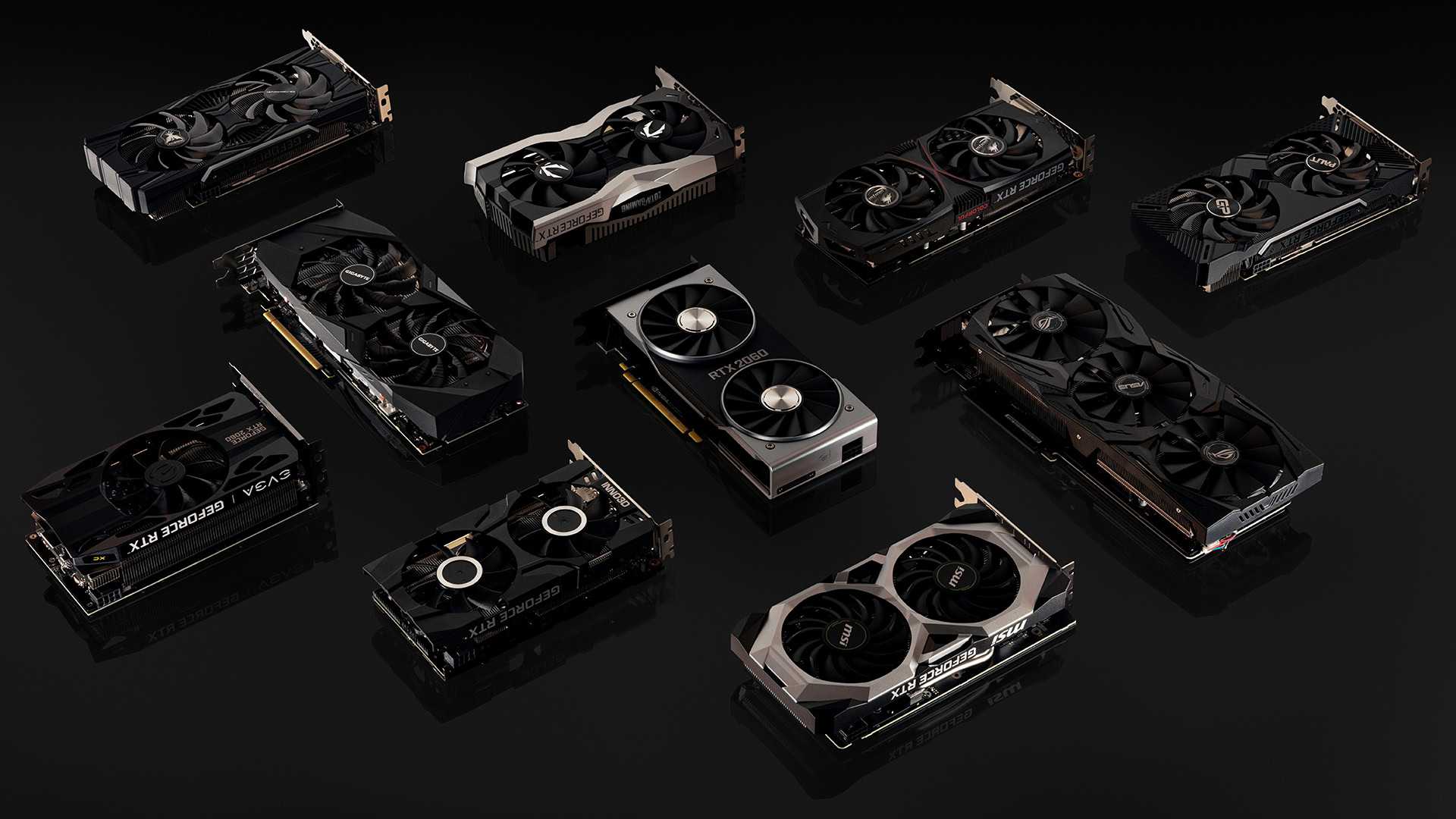
Many of us already own a workstation or gaming PC. If this sounds like you, there’s good news! You don’t have to pay anything upfront to start mining — as long as your graphics hardware is relatively modern and performant. This is because graphics processing units, or GPUs, excel at running the algorithms used for mining.
See also: What is a GPU?
More specifically, any graphics card more powerful than the NVIDIA GTX 1060 or the AMD RX 480 8GB will do just fine for mining Ethereum. These were marketed as mid-range GPUs back in 2016, so the chances are that more recent gaming PCs will match or surpass them.
For Ethereum mining specifically, you’ll need a card with a minimum of 6GB of video memory. This means lower-end cards like the GTX 1050 Ti and 1650 are ineligible.
At the time of writing this article, a higher-end graphics card like the NVIDIA RTX 3070 can yield around $1.5 a day, although that figure soared as high as $4 in the past. The cheaper GTX 1660 Ti, on the other hand, will earn a little more than half as much. However, it’s worth noting that these numbers are not absolute. GPU power efficiency plays a significant role in calculating profitability — more on that in a later section.
Each GPU can net you a profit of $1-5 per day, not bad for completely hands-off income.
In case you’re unsure about your card’s capabilities, we would recommend using an online calculator like WhatToMine or Nicehash’s handy profitability calculator. These websites are useful for estimating your GPU’s performance for mining, and gaining a general understanding of your potential income.
You can, of course, use as many graphics cards as you want for mining — the only upper limit is your budget (and your home wiring’s power limit).
Read more: All AMD GPUs explained, and the best AMD GPU for you
Do note that if you’re buying new graphics cards solely for cryptocurrency mining, calculate how long it would take you to recoup the initial investment. Computer hardware is usually in short supply when mining profitability spikes, so ensure you aren’t overpaying significantly. Any longer than a few months to break even on your purchase, and you’re probably better off not participating at all.
Step 2: Optimize your hardware, or take a shortcut
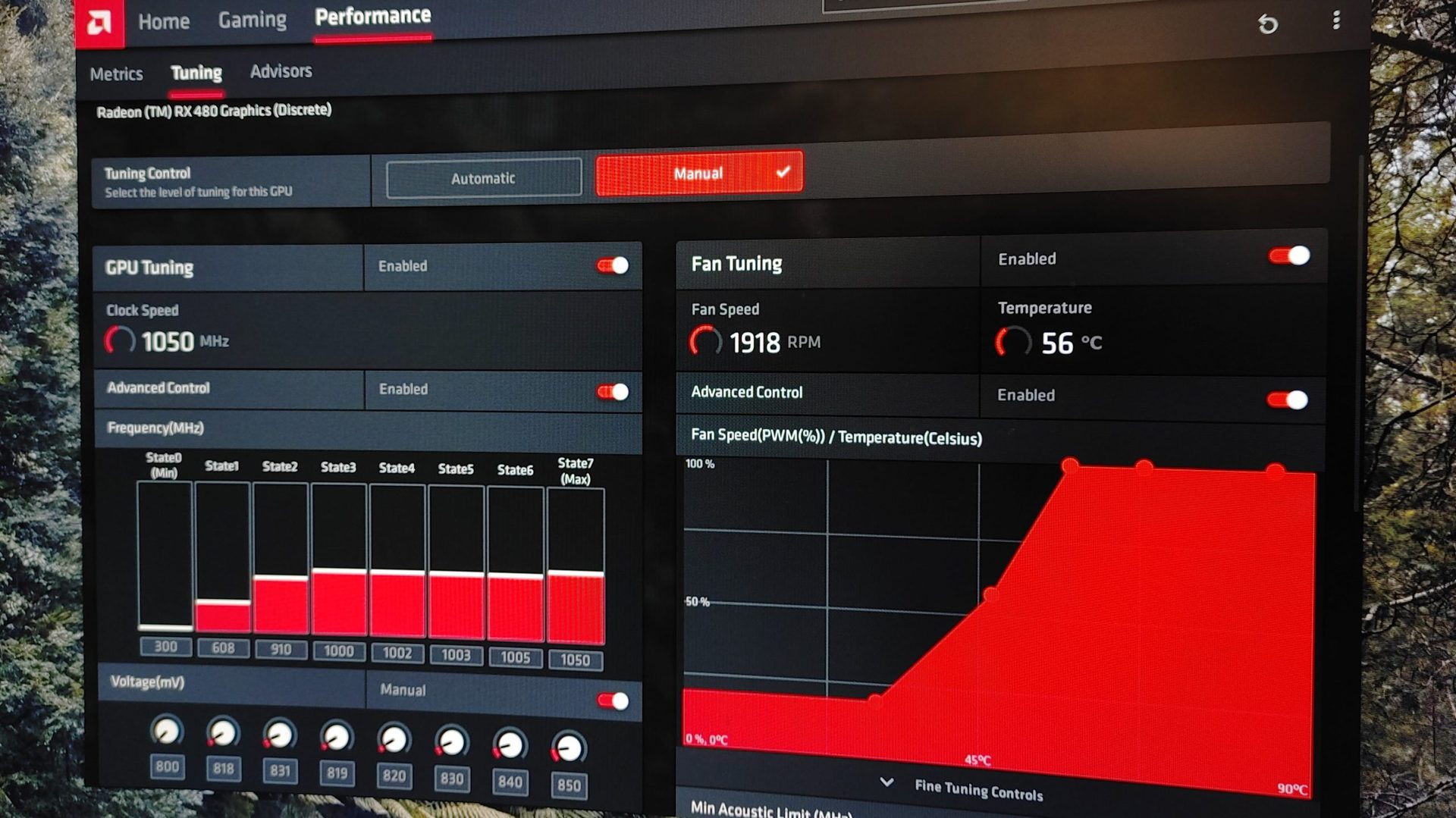
As you’ve probably guessed by now, most graphics cards weren’t designed with cryptocurrency mining in mind. To that end, it’s important you do not push your cards to the limit. Most gaming or graphics applications aren’t nearly as intensive or continuous as mining, so most miners artificially limit GPUs to prevent premature failure.
Another reason to dial back your hardware’s capabilities is power consumption. Mining at full bore may net you slightly more income, but you will likely pull drastically more power from the wall at the same time.
For all of these reasons, it is essential to find the best balance between performance and power consumption. However, given the myriad of different graphics hardware brands, architectures, and generations, no one can offer universal advice on optimizing your particular setup. In other words, prepare for a bit of trial and error.
Mining at full bore may net you slightly more income, but you will likely pull drastically more power from the wall at the same time.
The first step to fine-tuning your graphics card involves downloading an overclocking software of your choice. MSI Afterburner is the de facto choice these days, so you might as well install it. For AMD graphics cards, you could also use the Radeon Software bundled with the drivers.
You should set your GPU’s maximum power limit to around 70 to 80% of its factory setting as a general rule of thumb. From there, your priority is to raise your card’s core and memory clocks in small increments until you start to notice visual anomalies.
Dialing back your hardware prevents excessive energy consumption and premature failure.
Skipping the fine-tuning
If all of the above sounds too complicated, you may be better off using a fully automated mining tool such as Nicehash’s QuickMiner. The software essentially handles the overclocking bit for you. However, you should know that mining through Nicehash involves renting your computational power to other miners, who pay you in Bitcoin. Think of Nicehash as a marketplace that takes a small cut for the convenience it provides.
The other downside is that the QuickMiner software is only optimized for certain generations of NVIDIA GPUs. If you’re running AMD hardware, you’ll have to dial in the overclock settings yourself and use a different mining program.
Nicehash also offers a slightly more detailed overclocking guide for manual overclocking that you might find useful. In my experience, though, the best way to find and validate settings for your hardware is to peruse user forums such as the EtherMining subreddit or GPU mining-focused chat rooms.
Step 3: Pick a mining pool and software
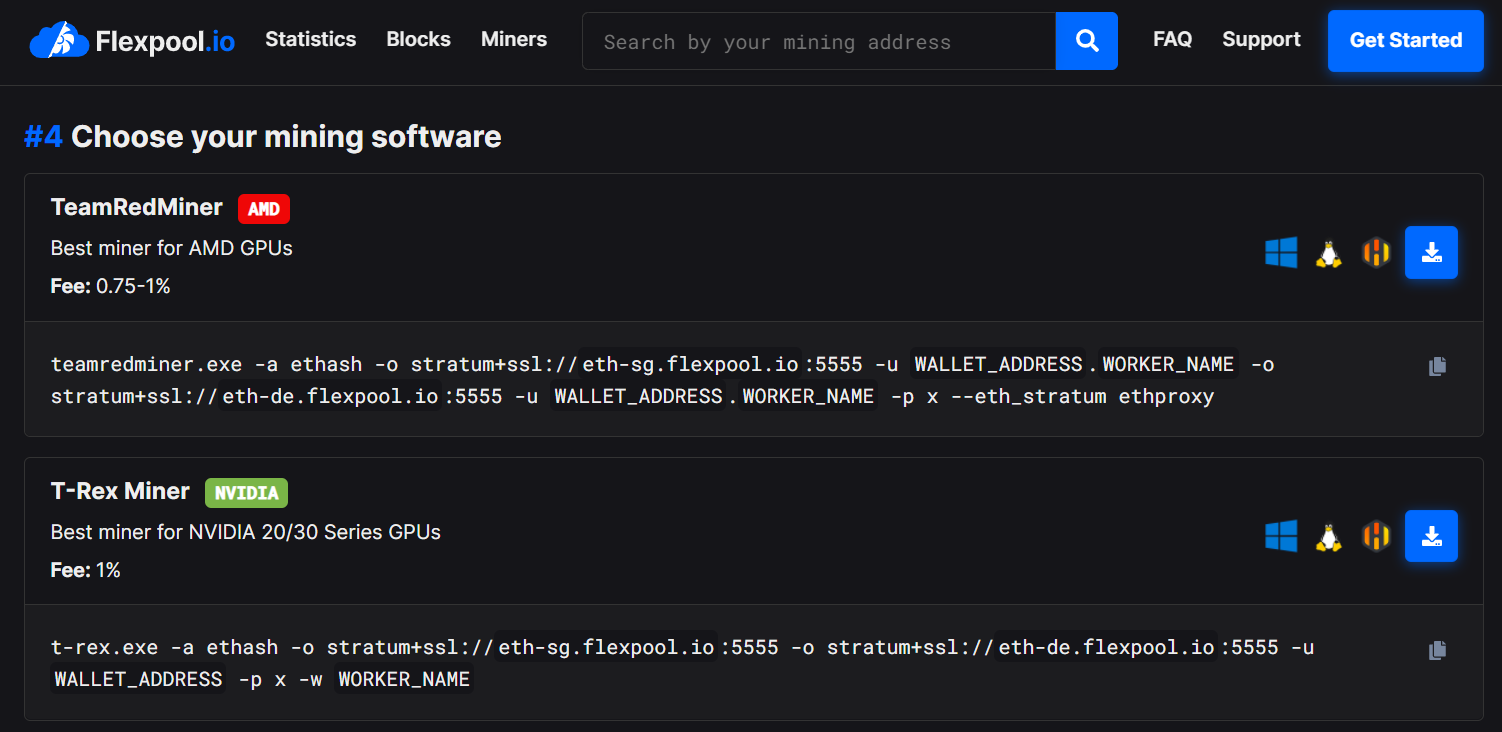
Cryptocurrency mining is a highly competitive process with only one winner. In other words, there is virtually no way you’ll be able to make any money via solo mining. Enter mining pools.
As their name suggests, pools combine computational power from hundreds or thousands of miners to boost everyone’s chances of finding a block. Then, whenever the pool stumbles upon a block, the rewards are split — proportional to each miner’s contributions, of course.
While the Ethereum network has dozens of pools, most of the top ones are functionally similar. After all, mining pools also have to contend with competition amongst themselves. If one is far worse than the other, it would quickly lose market share.
Mining pools help you join forces with other small time cryptocurrency miners.
It’s worth noting that you aren’t bound to any single mining pool. However, most pools include a minimum withdrawal threshold to prevent people from switching too frequently.
Ethermine is the largest Ethereum pool and one of the most consistent daily performers. Even so, your earnings will not differ much if you select a smaller pool like Flexpool, Hiveon, or Spark Pool. A bigger factor to consider is if the mining pool has servers near you — especially if you live outside North America and Europe.
Mining pool websites offer configuration guides for the most popular mining programs. Getting started is as simple as copying and pasting a few lines in most cases.
As for which program you should use, there is no single correct answer. Mining software choice varies depending on your hardware. For instance, TeamRedMiner only works on AMD hardware, while T-Rex Miner is limited to NVIDIA graphics cards.
Step 4: Configure the miner and start mining
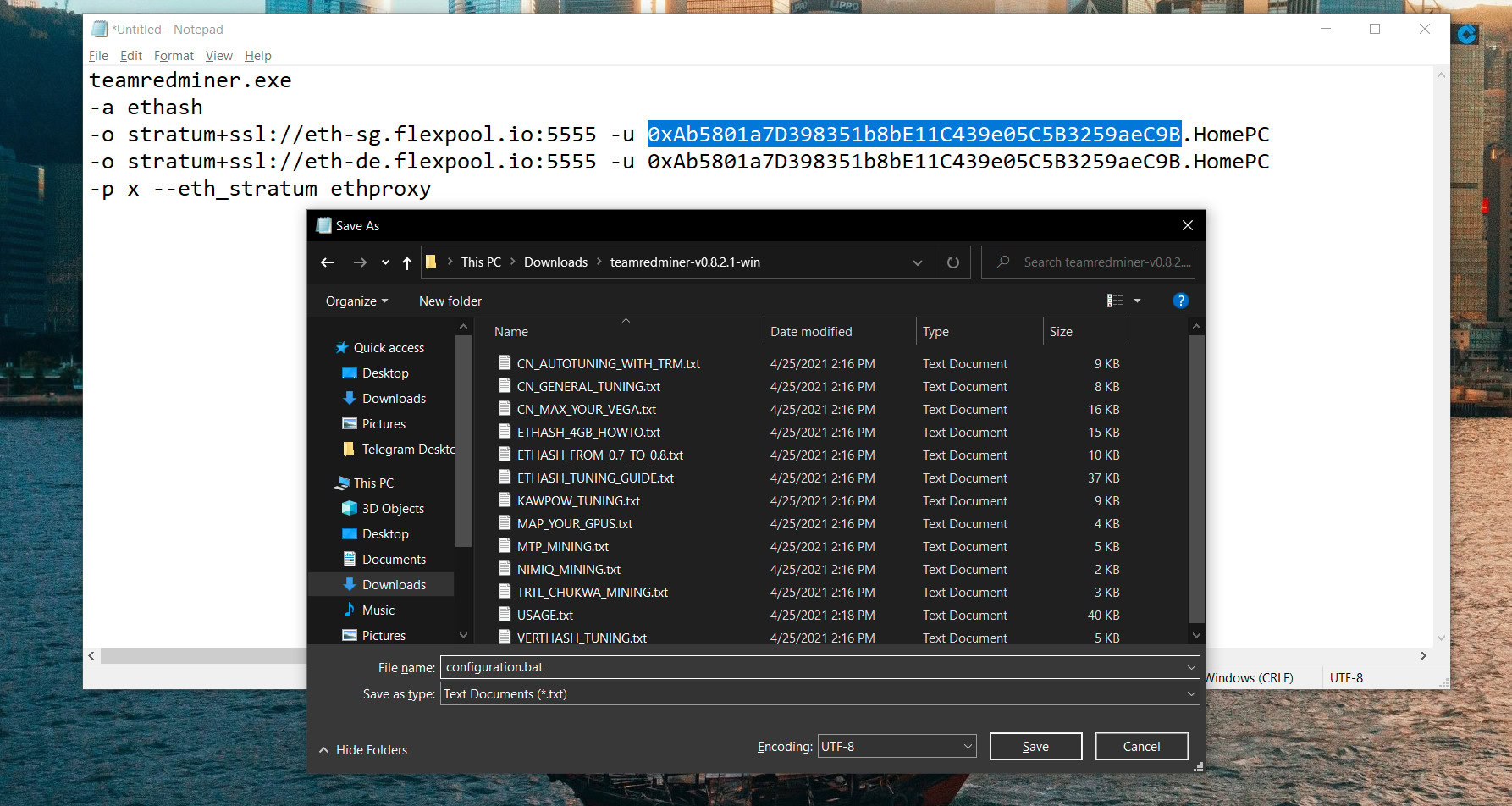
Even though most pools provide accurate configuration files, they fail to guide users through the most crucial step — actually setting up the miner. Let’s take an example then and set up a miner by ourselves. While we’ll be using Flexpool and TeamRedMiner in the following screenshots, the steps are essentially the same for any other pool/software combination.
Flexpool’s Getting Started page provides us with valid configuration lines for various mining programs. Simply copy one of the fields and paste it into a new Notepad file.
Then, change the values as per your needs — particularly the WALLET_ADDRESS part. When you’re done, save the configuration file in the TeamRedMiner folder with a .bat at the end as shown in the above screenshot. This creates a custom executable file so that you don’t have to input these values every time.
Finally, double-click the file you just saved to start the miner. You should be greeted with a terminal window that looks something like this:
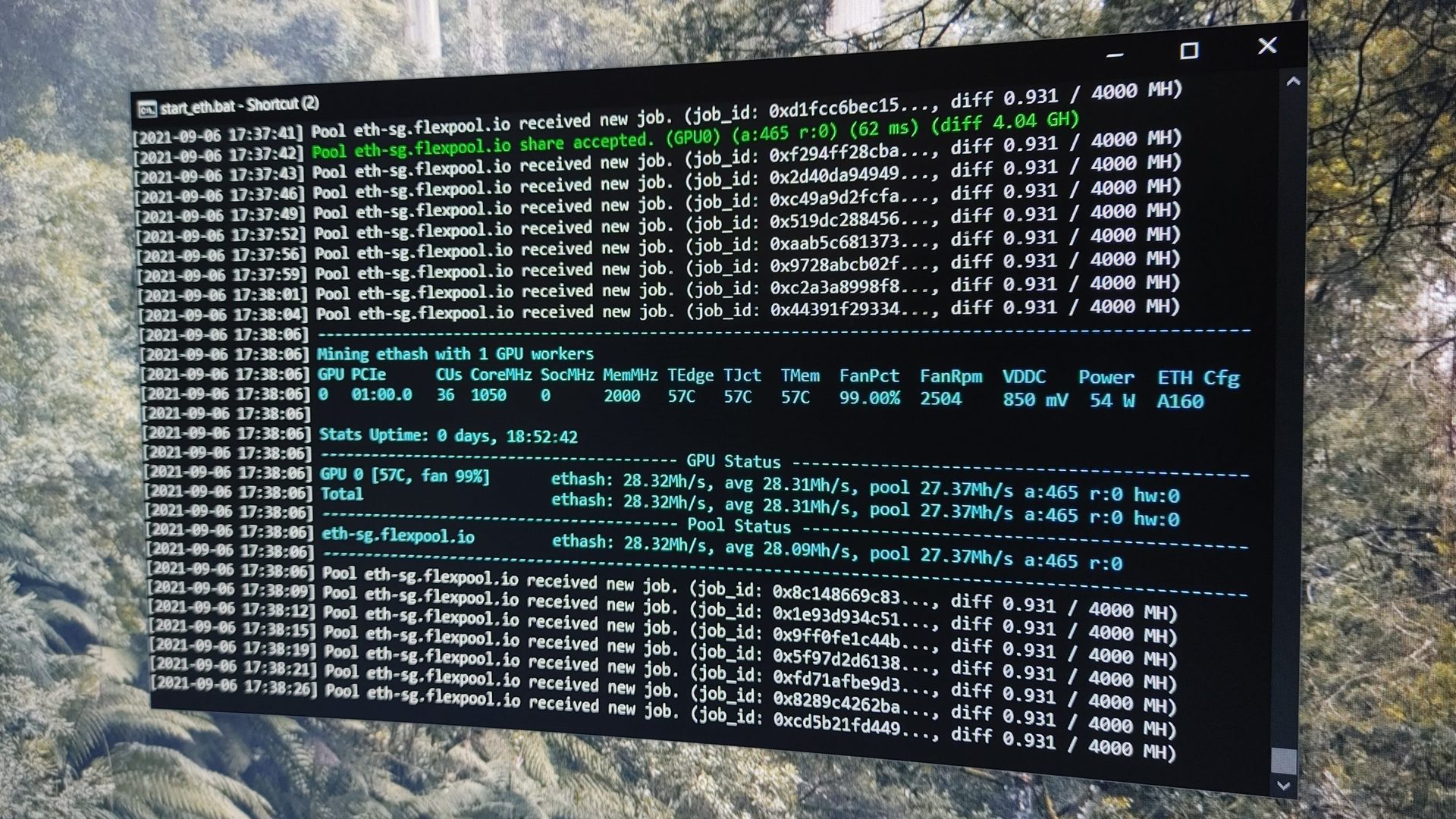
From this point on, you can start tracking your miner’s performance from either the newly opened terminal window or the mining pool’s dashboard. Here’s an example of the latter:
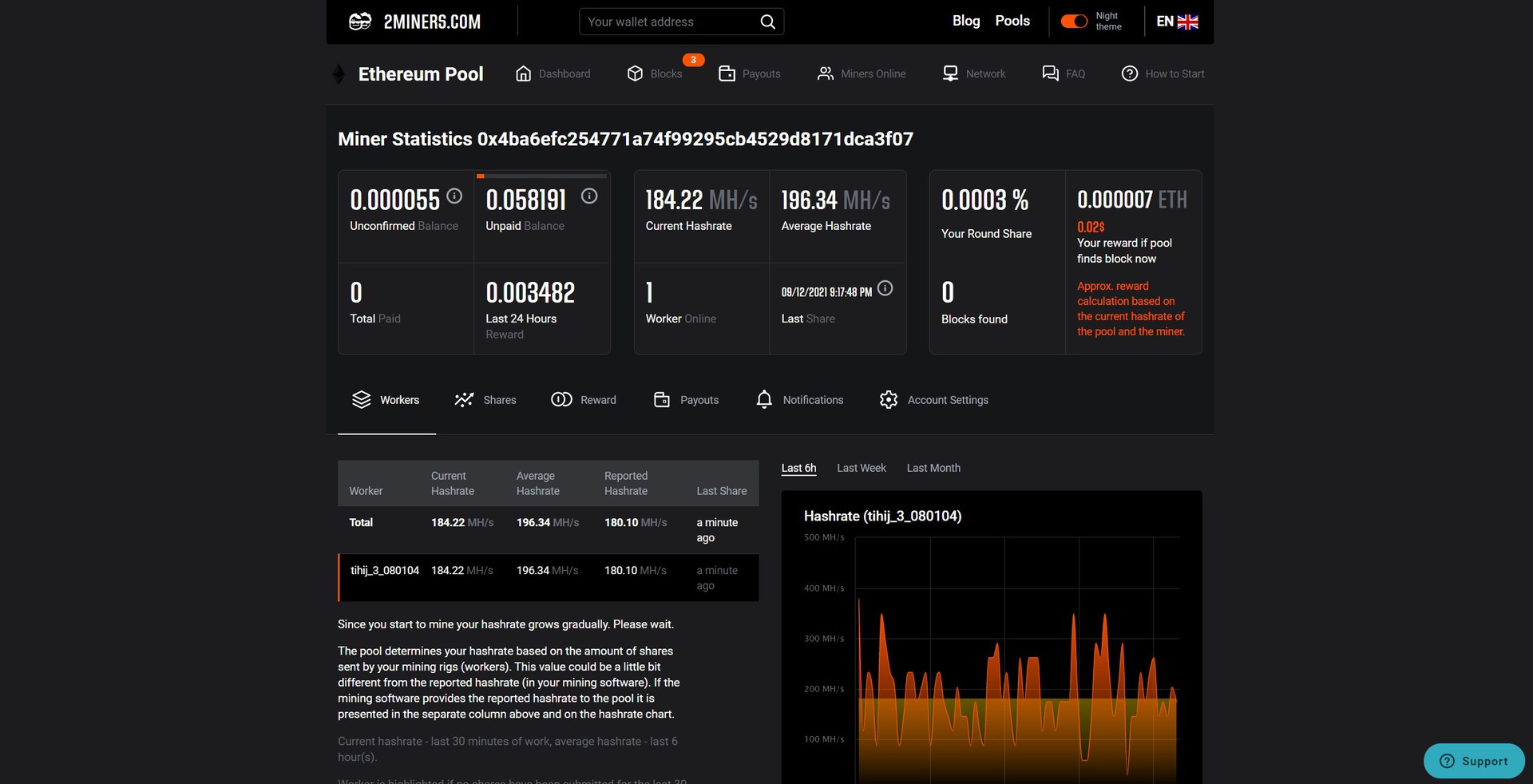
Once you mine the minimum threshold set by the pool, your earnings will be automatically transferred to your wallet. Some pools also allow you to set your own threshold or initiate a manual payment, but be warned that payouts are subject to transaction fees.
Read more: What is a cryptocurrency wallet? Everything you need to know
Managing costs and risks while mining Ethereum
A common misconception among those new to the cryptocurrency ecosystem is that mining yields consistent and reliable revenue. However, this is far from the truth as it is certainly possible to lose money if you’re not careful.
To that end, there are some key considerations and decisions to make before starting out. Whether you’re mining on a single graphics card or a dozen, you will have to account for electricity prices, hardware efficiency, and even Ethereum’s own price volatility. Here are a couple of things you should know as a new cryptocurrency miner.
Keep your electricity usage in check
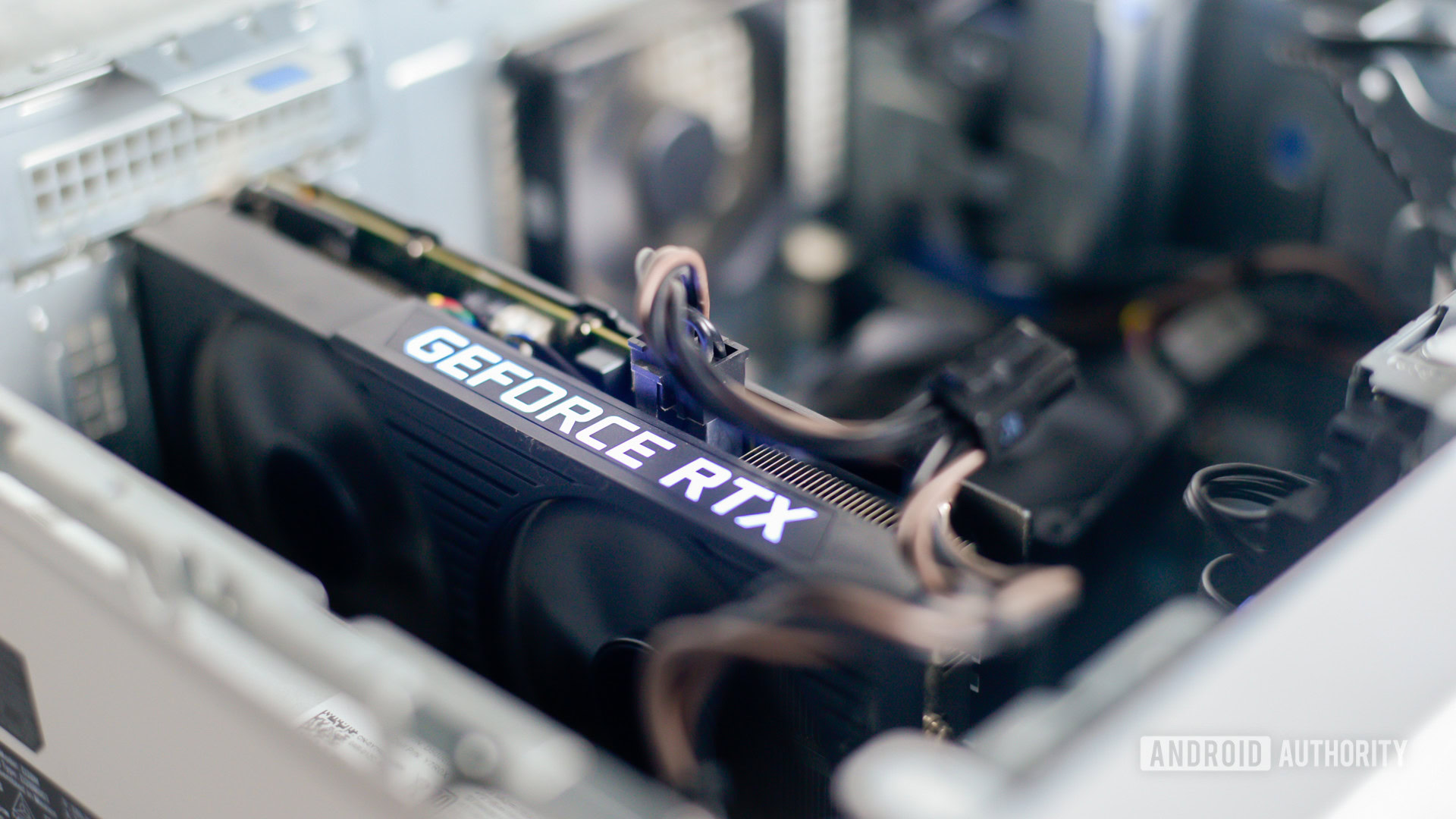
The biggest cost to swallow as a cryptocurrency miner is an ongoing one. Graphics cards, especially more modern ones like the NVIDIA 3000-series, are extremely power-hungry. If you live in an area with moderate to high electricity prices, this can quickly put a dent in your profits.
The first step to estimating your efficiency is to figure out how much you pay your utility company. This is often quoted in per kilowatt-hour terms, like $0.12/kWh. For instance, if you’re mining in Germany, your household electricity rate is likely around $0.30/kWh. In that case, mining will be a lot less profitable than if you lived elsewhere. For context, the global median electricity rate is around 13 cents per kilowatt-hour.
This is why it is vital to dial in your overclock settings to the point of maximum efficiency. To know how much power your graphics card will consume, reference the manufacturer’s website.
How to calculate electricity costs
An RTX 3070, for instance, should consume around 220 watts each. With power limiting and underclocking (see Step 1), you can bring that figure down to around 150-160W or 0.16 kilowatts. Factor in another 50-100 watts to account for the rest of the computer, and you end up with a (very approximate) 0.25-kilowatt figure.
Now, you have all the data needed to calculate your mining rig’s daily or monthly power costs. Simply use the following formula:
Electricity Cost($/day) = Power(in kilowatts) × time(in hours) × Cost($ per kWh)
Using our numbers for the RTX 3070-equipped computer from earlier, we can calculate the cost as follows:
Electricity Cost($/day) = 0.25 × 24 × 0.13
= $0.78 per day
Over 30 days, this hypothetical mining rig would translate to your power bill rising by approximately $23.40.
Remember that the above calculation only accounts for a single graphics card and assumes a $0.13/kWh electric rate. The bottom line is you need to make more than $23.40 in mined ETH each month for the activity to be worthwhile.
We recommend using a power meter such as the Kill-a-Watt to properly gauge your mining rig’s total electricity consumption and run the above calculations based on those numbers.
Watch Ethereum’s price and prepare for volatility

The final wildcard to watch out for is the price of the cryptocurrency you’re mining — Ethereum in our case. This is because mining rewards are paid out in ETH, and the responsibility falls on you to exchange that for US dollars. If you wait a month or even a few days, the dollar value of your holdings will change significantly.
Furthermore, unless you’re running a substantial mining operation, the time between payouts will likely range from a couple of weeks to a month and beyond. All this is to say that you may want to keep an eye on the cryptocurrency market’s movements. If Ethereum’s price drops too far, you may end up spending more on electricity than what you earn through mining.
The cryptocurrency market is known for its volatility, don't let it catch you off-guard.
Ultimately, however, you have to accept the risk that your mined rewards could diminish or increase in value by the time you liquidate them. This is not as big a problem as it sounds if you’re patient — many miners hold onto their earnings for years as an investment. If you’re only mining for short-term gains, you should not buy a truckload of hardware specifically for mining.
Read more: A definitive guide to buying and selling cryptocurrency
Cryptocurrency mining: How much money can you expect to make?
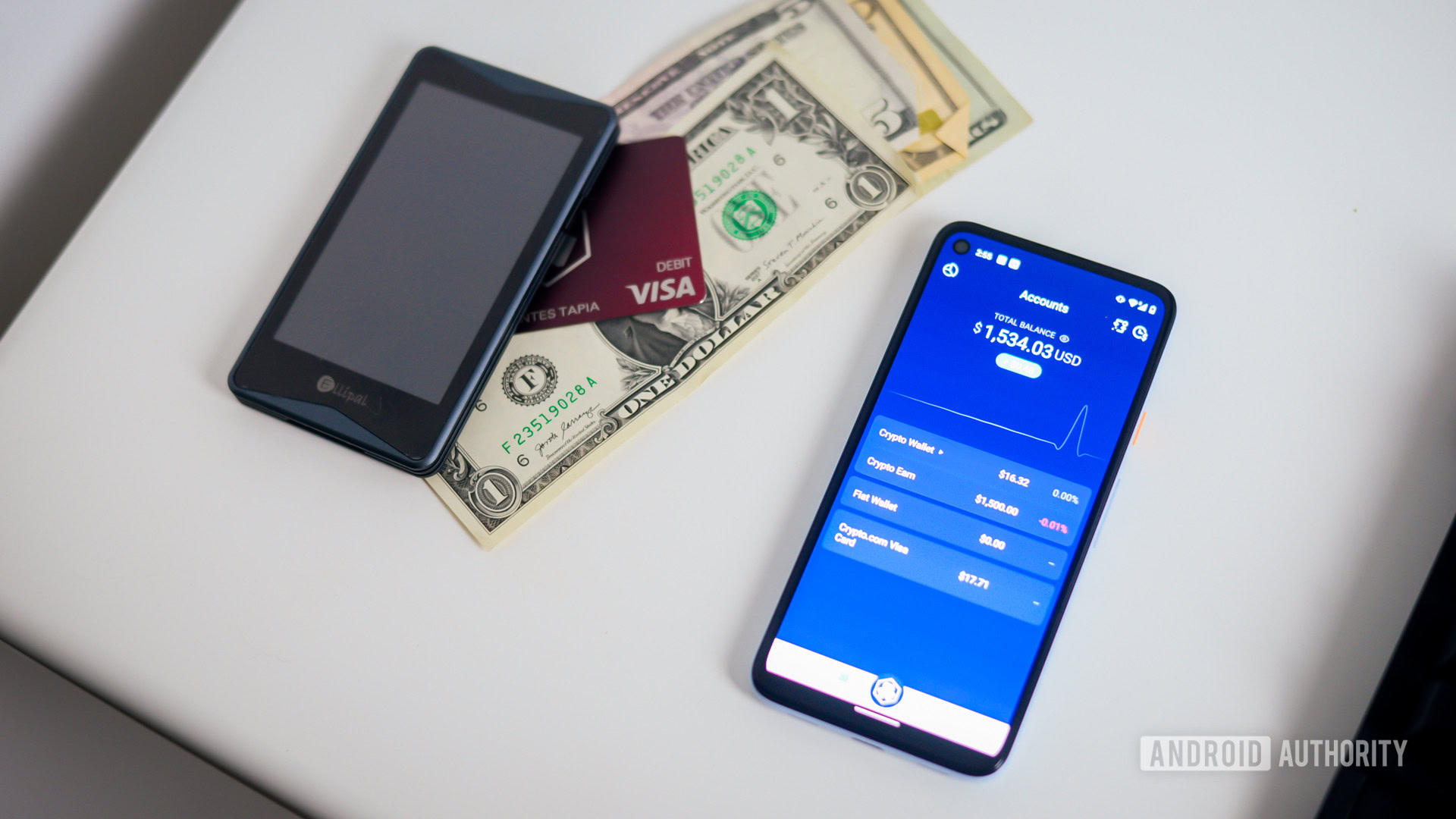
With the technicalities out of the way, let’s discuss numbers. How much money can you expect to make by mining cryptocurrency?
Unfortunately, there’s no universal answer to this question. There are simply infinite hardware combinations, and electricity prices too can vary significantly from one region to another. Having said that, there are a few shortcuts to determining the profitability of your specific hardware setup.
As mentioned previously, websites like WhatToMine offer a reasonably up-to-date estimate of potential earnings. However, keep in mind these numbers are calculated based on data from the past week or 30 days. In other words, nobody can guarantee future earnings. Like any other business venture, nothing about mining is set in stone.
Cryptocurrency mining also depends heavily on luck, so even if everything stays the same, your earnings may vary. The following screenshot, for example, represents a relatively modest mining rig. Notice how the earnings change a bit every day? That’s completely normal.
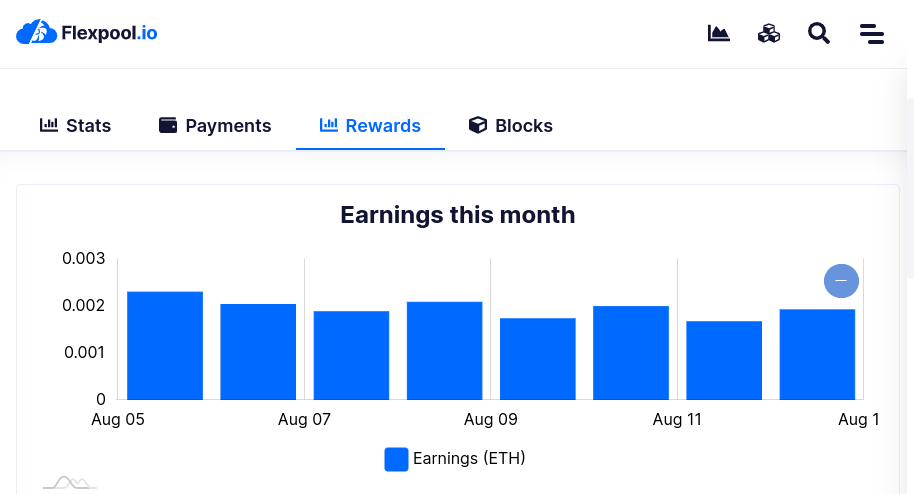
Several factors could sway your profitability in the short and long term, including increased competition from other new miners such as yourself. If you have limited experience with the digital currency market, starting small and modest is a good idea. This is because it can take several months for you to recoup your initial investment, especially if you overpay for the hardware in the first place.
FAQs
Absolutely not! Cryptocurrencies rely on miners to achieve decentralization, so the bar to entry is kept as low as possible. If you don’t care about profitability, you can even contribute to the network’s security by mining on outdated hardware. Just don’t expect to earn much in return.
In the early days of cryptocurrency, most people sold their tokens to another individual directly for cash. However, a more convenient option would be to use a cryptocurrency exchange.
Cryptocurrency mining by itself does not negatively impact the lifespan of your graphics card. However, subjecting computer hardware to high temperatures can easily lead to higher failure rates. To that end, it’s in your best interest to reduce the power limit as far back as needed. This will not only prolong your GPU’s lifespan, but also improve its efficiency and overall profitability.
Most likely, yes. Most nations — including the US, UK, and Canada — regard cryptocurrency mining payouts as ordinary income for tax purposes.
If you mine on a large scale, you can also opt for deductions against expenses such as hardware acquisition and electricity costs. However, you will have to structure your mining operation as a business to opt for these benefits. For more information, consult your national tax agency’s website.